For anyone who missed the last entry in the G.O.A.T. Villains series, you can check out numbers 24 (Clarence Boddicker) & 25 (Bohdi).
Entry no.25 also carries an explainer re: criteria.
And now, No. 23.
Let the ritual begin….
MOLA RAM
Steven Spielberg hates it. George Lucas winces at it. Raiders writer Laurence Kasdan, refused to script it. It’s been described as excessively violent, culturally offensive, & a ‘cinematic form of child abuse’.
What greater recipe for a blockbuster sequel is there?
I am, of course, talking about Indiana Jones & The Temple of Doom (1984).
A film explained, according to Lucas, by the difficult times two Hollywood titans were experiencing in their personal lives:
Part of it was I was going through a divorce, Steven had just broken up, and we were not in a good mood, so we decided on something a little more edgy.
An edginess Spielberg would later balk at:
It was too dark, too subterranean, and much too horrific. It out-poltered-poltergeist.
There’s no doubt Raiders of the Lost Ark is technically the best film of the trilogy (we shall proceed as if 4&5 don’t exist), & Last Crusade, with its affectionate humour & paternal depth following a star turn from Sean Connery, probably the most fondly remembered.
But Temple of Doom has always been my favourite.
For much of the reasons Spielberg disowned it, but chiefly because it features the most foul villain to appear in any Indiana Jones adventure (no, even Hitler’s cameo in part three doesn’t come close) - Amrish Puri’s Thuggee High Priest, Mola Ram.
A genocidal, heart-ripping, black blood-drinking, Shiva-betraying, Hebrew-sacrificing, child-enslaving, sadistic madman bent on retrieving the five Sankara stones to oversee Hindu goddess Kali’s reign of death.
You don't believe me? You will, Dr. Jones. You will become a true believer.
Temple of Doom explodes into life in its first act.
Kate Capshaw’s Willie Scott emerges from a crimson fog billowing out of a dragon’s mouth in a dazzling, diamond-studded blood-red dress to perform the opening musical in a pitch perfect beginning that hints at the paletted horror to come.
Anything goes.
In fact, Roshan Seth, who played Chattar Lal, later suggested it was the greatest ever opening 15 minutes of cinema, & it’s hard to disagree as Indy swaps China’s past for poison with devious Lao Che & his chortling goons in an edge-of-your-seat trade-off.
But far darker foes lie in wait, in the bowels of Pankot Palace….
Seth anointed Amrish Puri ‘India’s greatest ever villain’, & Mola Ram was to show the world what his country had already begun to see in the early 1980s.
Puri was a prolific actor, appearing in over 450 films, often as a baddie in Hindi cinema, & is known as one of the most succesful villains in Bollywood despite an early career full of struggle (he didn’t get cast in a main role until he was nearly 50).
It was his star turn as a villain in the 1980 hit Hum Paanch that really made people take note of the man with the imperious bearing & booming baritone.
Spielberg & Lucas had also struggled - to initially cast the role of Mola Ram, until Spielberg flew out to India to meet Puri on set, simultaneously engaged in shooting a staggering 22 films, after the actor refused to audition.
Needless to say, Spielberg was convinced.
To transform into the deranged thuggee cult leader, Puri shaved his head, a look he would later keep - not least because it allowed him to wig-morph into ever more elaborate villains.
Temple of Doom’s story has it that when the British destroyed ancient cult the Thuggee, a priest hid the last of the lost Sankara stones in the catacombs beneath Pankot Palace.
After stealing one of their number from an Indian village, kidnapping their children & driving them underground to dig for the final two, Ram’s aim is to wipe out their imperial masters, destroy all religions, & rule the world in the name of Kali Ma.
It’s high fantasy, yet Puri was labelled ‘anti-national’ in India for the portrayal of the Thuggee, & the film came under fire even for the tongue in cheek banquet scene, with its slithering snakes, barbequed bugs & chilled monkey brains.
Here is Amrish in his autobiography, The Act of Life:
…it's based on an ancient cult that existed in India and was recreated like a fantasy. If you recall those imaginary places like Pankot Palace, starting with Shanghai, where the plane breaks down and the passengers use a raft to jump over it, slide down a hill and reach India, can this ever happen? But fantasies are fantasies, like our Panchatantra and folklore. I know we are sensitive about our cultural identity, but we do this to ourselves in our own films. It's only when some foreign directors do it that we start cribbing.
For the villagers, Indy is a reluctant saviour sent from Shiva, and by the time you get past the sheen & sophistry of the Maharajah & his minions, by the time you get down to the catacombs, through a scrawl of twisted passageways, saw-toothed speleothems & hot fire boiling from the deeps, you realise why Spielberg later recoiled so violently: this is hell.
And Mola Ram is the High Priest of darkness.
A demented zealot - with his unblinking, wide-eyed, bloodshot stare, a smoulder soundtracked by the rythmic beating, & black-blood-fuelled chanting, of chained slaves as he oblates a Hebrew to Kali.
Bali Chadhogay. Bali mangthi Kali ma. Mukti degi Kali ma. Kali ma… Kali ma… Kali ma, shakthi deh!
(You will be sacrificed. Sacrifice is what Mother Kali desires.Mother Kali will give salvation. Mother Kali… Mother Kali… Mother Kali, give me power!)
Ram’s hand quivers with divine latency over the sacrifical victim as he calls on the power of his dark mother to rip a heart, still beating, from the innocent’s chest; eyes agog as he pleads feverishly for salvation.
Yet Ram, brimming with glee & malevolence as his offering is plunged into the goddesses’ fire, only cackles exultantly as the organ bursts into flame.
It’s masterful from Puri - intense, hellish, hypnotic; & one viewing is all it takes for the scene to be burnt into your consciousness forever more. In fact, it’s no surprise this film led the MPAA to create the PG-13 rating.
Even the shrill Willie Scott is silenced in terror as she gawps on with Indy & Ke Huy Quan’s Short Round.
It’s not hard to decode the symbolism of the scene if Lucas & Spielberg were mired in relationship heartbreak, even though the latter later claimed ‘There’s not an ounce of my own personal feeling in Temple of Doom.’
Sure.
But out of their trauma, they created one of the most iconic moments in cinema history.
And the diabolical Mola Ram, with all his menace & cult charisma, is at the heart of it (sorry).
He steals the scene once again when Indy is captured & forced to drink the black blood of Kali.
Jones spits the first attempt back at his tormentor, & with blood dripping down his face, Mola Ram orders him whipped. Brutally.
Short Round is enslaved (albeit not for long), and there are other plans for Willie.
The British in India will be slaughtered. Then we will overrun the Muslims. Then the Hebrew God will fall, and then the Christian God will be cast down and forgotten.
Soon, Kali Ma will rule the world.
For the first - & only - time in an Indiana Jones flick, the magnetic Ram feels like a worthy counterpoint to possibly the greatest hero of all time, largely due to his own bearing & gravitas, but also due to the confined nature of the narrative & subterranean setting.
The other films are more sprawling, & the villains either synonymous Nazis or Soviets. In the case of Raiders, there is very little physical confrontation with Paul Freeman’s Rene Belloq, & as much as Ronald Lacey deserves his flowers for SS Sturmbannfuhrer Arnold Ernst Toht, he was a secondary antagonist.
Pat Roach (who appears again in Doom as the Thuggee overseer flattened by a rock crusher) provided the real physical heft.
Julian Glover’s Walter Donovan in Last Crusade is similar to Belloq - a shadowy presence, but here, & later on the bridge, there is a direct physical antagonism alongside the Manichean struggle.
And then, of course - Mola Ram succeeds where others failed.
Indiana Jones turns bad.
Compelled by the black blood of Kali to sacrifice Willie Scott in her honour as Mola Ram presides.
And when Short Round saves the day, Ram disappears like a phantasm through a trap door under the giant skull housing the Sankara stones, pealing wicked laughter.
The film’s triple threads of extravagant action, humour & horror pivots back to the former with the iconic minecart chase as Indy & co. escape the catacombs after liberating the village’s children.
But it all comes to a head on the rope bridge.
We see Mola Ram in all his fiendish inglory, casually using his own acolytes as shields, even tearing one of their number from the hanging bridge to save his own soul.
And this time it’s Jones’ turn to nearly have his heart plucked from his body.
But instead he beats the High Priest at his own game - channelling the power of Shiva, face twisted in a fanatic snarl to rival the zeal of Mola Ram, who does an incredible job of showing his certainty morph into mortal fear as he’s overcome by Jones’ ferocity & the burning Sankara stones.
The Stones are mine!
Before he plunges to his (Wilhelmed scream) death, & is torn apart by crocodiles.
Ironically, the least graphic termination of all Indy’s foes.
But it’s pure cinema, & whatever their feelings about the film, there’s no doubt how Lucas & Spielberg in particular, feel about one of its stars:
Amrish is my favourite villain. The best the world has ever produced and ever will.
Amen.
Or better yet - Mola Ram Sudha Ram!






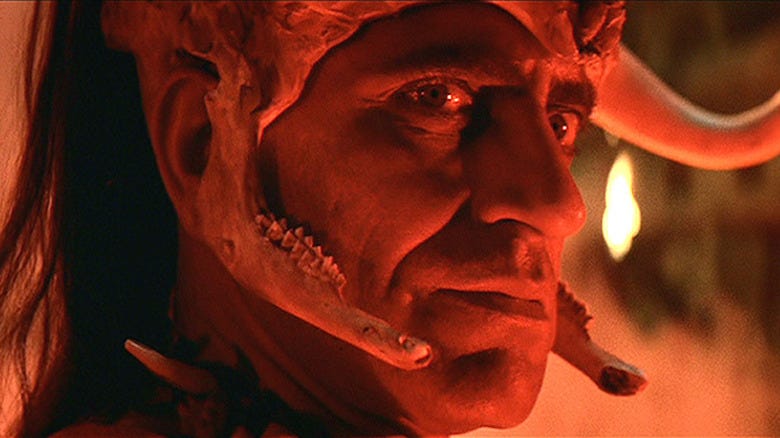

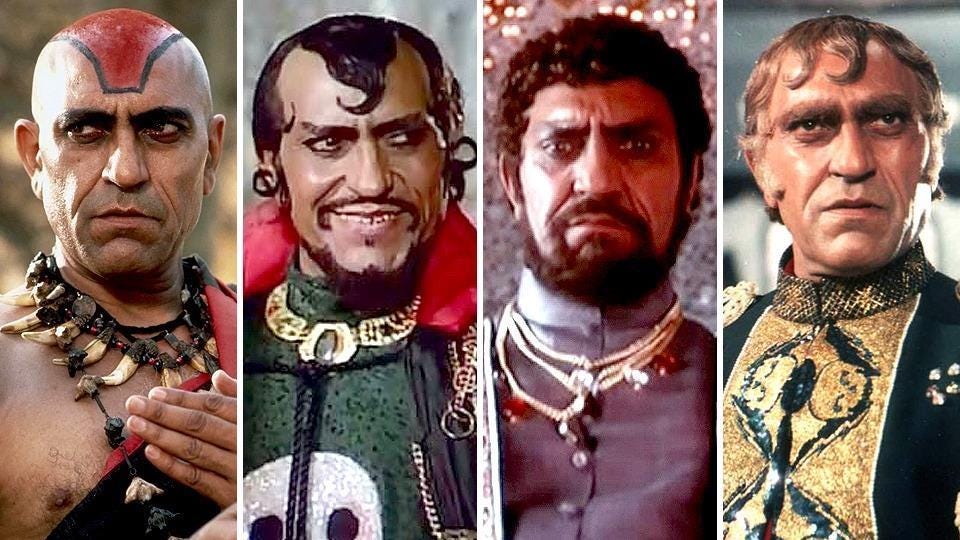
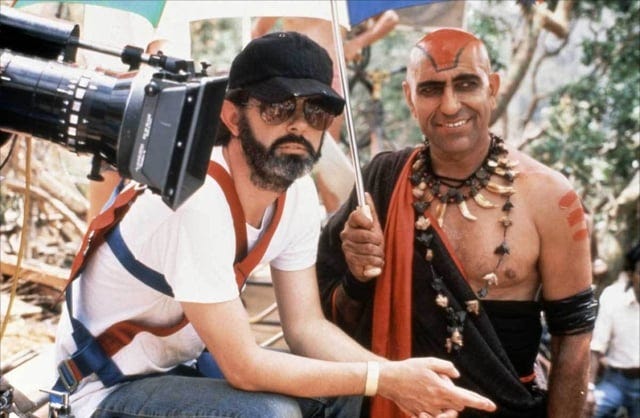
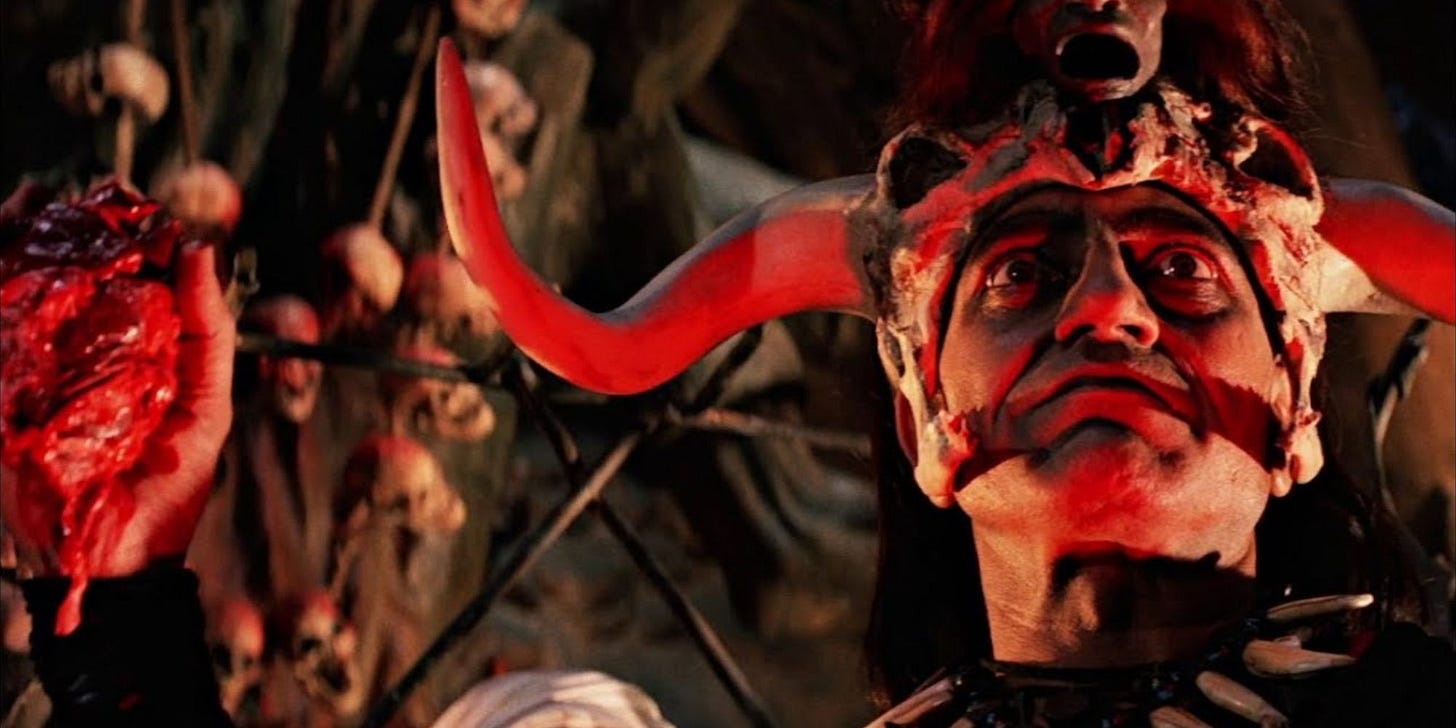
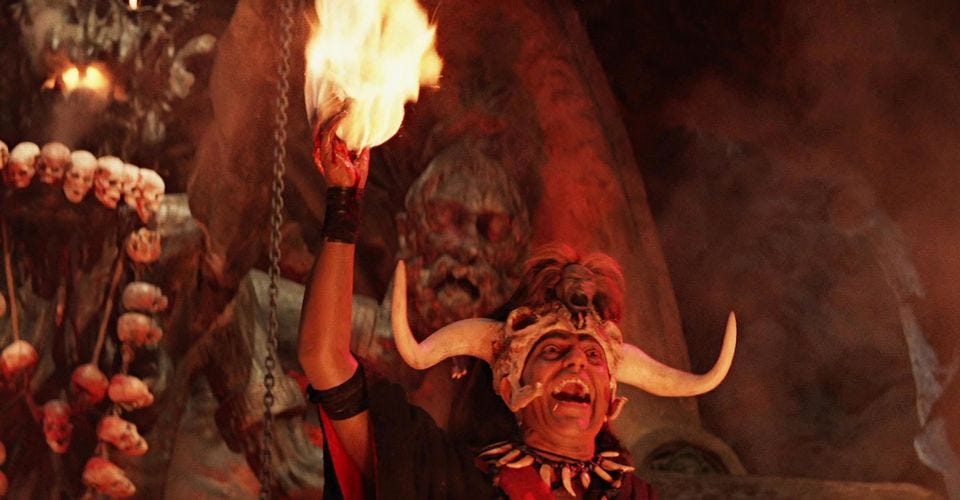


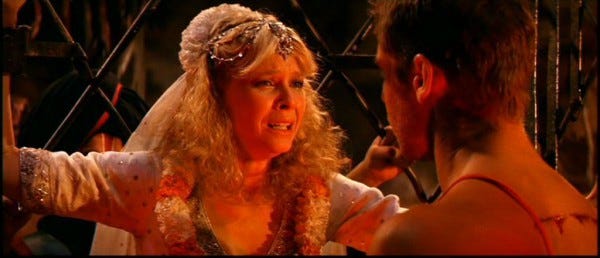


It’s actually such a dark film isn’t it!